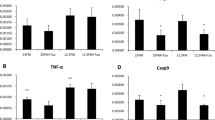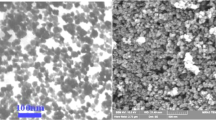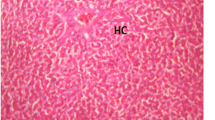Abstract
The practice of replacing costly animal-derived proteins with more economical plant proteins has augmented the risk of mycotoxin contamination in fish feeds, including contamination with ochratoxin A (OTA). OTA is a secondary metabolite produced by molds commonly found in fish feeds that causes impairment of performance in several fish species and some hepatic biochemical alterations. However, the pathways involved in hepatic damage remain unknown and are limited to histopathological alterations. Purinergic signaling is a homeostatic system that continuously monitors the internal environment to detect injury primarily by two intercellular messengers: adenosine triphosphate (ATP) and adenosine (Ado). The objective of this study was to determine whether OTA-contaminated feed induces the release of nucleotides in the extracellular milieu, as well as whether ectoenzymes modulate ATP pro-inflammatory effects in liver of tambaqui (Colossoma macropomum). Final mean weight, weight gain (WG), and liver weight were significantly lower in tambaqui fed feeds containing 1.6 and 2.4 mg OTA/kg feed than in the control group. Liver ATP and Ado levels were significantly higher in tambaqui fed feeds containing 1.6 and 2.4 mg OTA/kg feed compared with control, while no significant difference was observed regarding adenosine diphosphate and adenosine monophosphate levels. Hepatic triphosphate diphosphohydrolase (NTPDase) activity (for ATP) was significantly greater in tambaqui fed feeds containing 1.6 and 2.4 mg OTA/kg feed compared with control, while adenosine deaminase (ADA) activity was lower. No significant difference was observed with respect to hepatic NTPDase activity (for ADP) or for 5′-nucleotidase activity. Finally, levels of liver metabolites of nitric oxide were significantly higher in tambaqui fed feeds containing 1.6 and 2.4 mg OTA/kg feed than in the control group. Based on these data, exposure to 1.6 and 2.4 mg OTA/kg feed impaired tambaqui growth performance associated with final mean weight and WG. Levels of two important intercellular messengers, ATP and Ado, increased in the extracellular space as a consequence of hepatic damage, exerting opposite immune responses. Finally, liver NTPDase and ADA activities were altered to modulate ATP and Ado levels, respectively, exerting anti-inflammatory effects to counteract OTA-induced hepatic injury.




Similar content being viewed by others
References
Aanyu M, Betancor MB, Monroig O (2018) Effects of feedary limonene and thymol on the growth and nutritional physiology of Nile tilapia (Oreochromis niloticus). Aquaculture 488:217–226
Anater A, Manyes L, Meca G, Ferrer E, Luciano FB, Pimpão CT, Font G (2016) Mycotoxins and their consequences in aquaculture: a review. Aquaculture 451:1–10
Baldissera MD, Souza CF, Zeppenfeld CC, Garzon LR, Descovi SN, Da Silva AS, Da Silva AS, Stefani LM, Baldisserotto B (2018) Purinergic signalling displays a pro-inflammatory profile in spleen and splenic lymphocytes of Rhamdia quelen fed with a feed contaminated by fungal mycotoxin: involvement on disease pathogenesis. Microb Pathog 123:449–453
Baldissera MD, Souza CF, Da Silva HNP, Henn AS, Duarte FA, da Costa ST, Da Silva AS, Baldisserotto B (2020) Diphenyl diselenide modulates splenic purinergic signaling in silver catfish fed feeds contaminated with fumonisin B1: an attempt to improve immune and hemostatic responses. Comp Biochem Physiol C 227:108624
Becker LV, Passos DF, Leal DBR, Morsch VM, Schetinger MRC (2019) ATP signaling and NTPDase in systemic lupus erythematosus (SLE). Immunobiology 224:419–426
Bernhoft A, Hogasen HR, Rosenlund G, Ivanova L, Berntssen MHG, Alexander J, Eriksen GS, Faeste CK (2017) Tissue distribution and elimination of deoxynivalenol and ochratoxin A in feedary-exposed Atlantic salmon (Salmo salar). Food Addit Contam Part A Chem Anal Control Expo Risk Assess 34:1211–1224
Chiu GS, Freund GG (2014) Modulation of neuroimmunity by adenosine and its receptors: metabolism to mental illness. Metabolism 63:1491–1498
Di Virgilio F, Vuerich M (2015) Purinergic signaling in the immune system. Auton Neurosci 191:117–123
Doleski PH, Leal DBR, Machado VS, Bottari NB, Manzoni AG, Casali EA, Moritz CEJ, Rocha ACA, Camillo G, Vogel FF, Stefani LM, Mendes RE, da Silva AS (2017) Diphenyl diselenide modulates nucleotidases, reducing inflammatory responses in the liver of Toxoplasma gondii-infected mice. Purinergic Signal 13:489–496
El-Sayed YS, Khalil RH (2009) Toxicity, biochemical effects and residue of aflatoxin B1 in marine water-reared sea bass (Dicentrarchus labrax L.). Food Chem Toxicol 47:1606–1609
Farag M (2005) Plasma proteins in Nile tilapia (Oreochromis niloticus) and common carp (Cyprinus carpio) exposed to ochratoxin-A and treated with some anti-toxins. Egypt J Agric Res 83:1397–1416
Fustin JM, Doi M, Yamada H, Komatsu R, Shimba S, Okamura H (2012) Rhythmic nucleotide synthesis in the liver: temporal segregation of metabolites. Cell Rep 1:341–349
Giusti G (1974) Adenosine deaminase. In: Bergmeyer HU (ed) Methods of enzymatic analysis. Academic Press, New York, pp 1092–1099
Gonçalves RA, Naehrer K, Santos GA (2018) Occurrence of mycotoxins in commercial aquafeeds in Asia and Europe: a real risk to aquaculture? Rev Aquac 10:263–280
Gonçalves RA, Schatzmayr D, Albalat A, Mackenzie S (2020) Mycotoxins in aquaculture: feed and food. Rev Aquac 12:145–175
Haskó G, Cronstein B (2013) Regulation of inflammation by adenosine. Front Immunol 4:e85
Idzko M, Ferrari D, Eltzschig HK (2014) Nucleotide signalling during inflammation. Nature 509:e310
Kebede H, Liu X, Jin J, Xing F (2020) Current status of major mycotoxins contamination in food and feed in Africa. Food Control 110:106975
Lautert C, Ferreiro L, Zimmermann CEP, Castilhos LG, De Jesus FPK, Zanette RA, Leal DBR, Santurio JM (2014) Efeitos in vitro de ocratoxina A, deoxinivalenol e zearalenona sobre a viabilidade celular e atividade de E-ADA em linfócitos de frangos de corte. Pesqui Vet Bras 34:1173–1180
Lowry OH, Rosebrough NJ, Farr AL, Randall RJ (1951) Protein measurement with the Folin phenol reagent. J Biol Chem 193:265–267
Manning BB, Ulloa RM, Li MH, Robinson EH, Rottinghaus GE (2003) Ochratoxin A fed to channel catfish (Ictalurus punctatus) causes reduced growth and lesions of hepatopancreatic tissue. Aquaculture 219:739–750
Mansour AT, Omar EA, Soliman MK, Srour TM, Nour AM (2015) The antagonistic effect of whey on ochratoxin a toxicity on the growth performance, feed utilization, liver and kidney functions of Nile Tilapia (Oreochromis niloticus). Middle East J Appl Sci 5:176–183
Rosemberg DB, Rico EP, Langoni AS, Spinelli JT, Pereira TC, Dias RD, Souza DO, Bonan CD, Bogo MR (2010) NTPDase family in zebrafish: nucleotide hydrolysis, molecular identification and gene expression profiles in brain, liver and heart. Comp Biochem Physiol B 155:230–240
Rushing BR, Selim MI (2019) Aflatoxin B1: a review on metabolism, toxicity, occurrence in food, occupational exposure, and detoxification methods. Food Chem Toxicol 124:81–100
Ryder JM (1985) Determination of adenosine triphosphate and its breakdown products in fish products by high-performance liquid chromatography. J Agric Food Chem 33:678–680
Savio S, Giorgi M, Robson S (2016) Ectonucleotidases in immunobiology. Encycl Immunobiol 2:424–431
Savio LEB, Mello PA, da Silva CG, Coutinho-Silva R (2018) The P2X7 receptor in inflammation diseases. Angel or Demon? Front Pharmacol 9:e52
Scherer R, Augusti PR, Steffens C, BochiVC HLH, Lazzari R, Radunz-Neto J, Pomblum SCG, Emanuelli T (2005) Effect of slaughter method on postmortem changes of grass carp (Ctenopharyngodon idella) stored in ice. J Food Sci 70:348–353
Souza CF, Baldissera MD, Descovi SN, Eslava-Mocha PR, Zeppenfeld CC, Gloria EM, Baldisserotto B, Da Silva AS (2020) Tea tree oil attenuates cerebral damage in silver catfish (Rhamdia quelen) fed with an aflatoxin-contaminated diet. Aquaculture 523:735223
Tatsch E, Bochi GV, Pereira RS, Kober H, Oliveira JR, Moresco RN (2011) A simple and inexpensive automated technique for measurement of serum nitrite/nitrate. Clin Biochem 44:348–350
Tola M, Kebede B (2016) Occurrence, importance and control of mycotoxins: a review. Food Sci Technol 2:1191103
Tschirren L, Siebenmann S, Pietsch C (2018) Toxicity of ochratoxin to early life stages of zebrafish (Danio rerio). Toxins 10:e264
Velázquez-Miranda E, Díaz-Muñoz M, Vázques-Cuevas FG (2019) Purinergic signaling in hepatic disease. Purinergic Signal 15:477–489
Wu TS, Lin YT, Huang YT, Yu FY, Liu BH (2020) Ochratoxin A triggered intracerebral hemorrhage in embryonic zebrafish: Involvement of microRNA-731 and prolactin receptor. Chemosphere 242:125143
Wu TS, Lin YT, Huang YT, Cheng YC, Yu FY, Liu BH (2018) Disruption of liver development and coagulation pathway by ochratoxin A in embryonic zebrafish. Toxicology and Applied Pharmacology 340:1–8
Zahran E, Manning B, Seo JK, Noga EJ (2016) The effect of Ochratoxin A on antimicrobial polypeptide expression and resistance to water mold infection in channel catfish (Ictalurus punctatus). Fish Shellfish Immunol 57:60–67
Author information
Authors and Affiliations
Corresponding author
Ethics declarations
Ethics approval
This experiment was approved by the Ethics Committee of Brazilian National Institute for Research of the Amazon under protocol number 004/2018.
Additional information
Publisher’s note
Springer Nature remains neutral with regard to jurisdictional claims in published maps and institutional affiliations.
Rights and permissions
About this article
Cite this article
Baldissera, M.D., Souza, C.F., da Silva, J.A. et al. Dietary exposure to ochratoxin A reduces growth performance and impairs hepatic purinergic signaling in tambaqui (Colossoma macropomum). Fish Physiol Biochem 46, 2055–2064 (2020). https://doi.org/10.1007/s10695-020-00854-0
Received:
Accepted:
Published:
Issue Date:
DOI: https://doi.org/10.1007/s10695-020-00854-0




